You know how some people are obsessed with stamp collections or fantasy football teams? Well, we're obsessed with cookbooks. (Surprise!) Here, we'll talk them.
Today: Ice cream tips that'll change the way you cook—er, churn—ice cream.
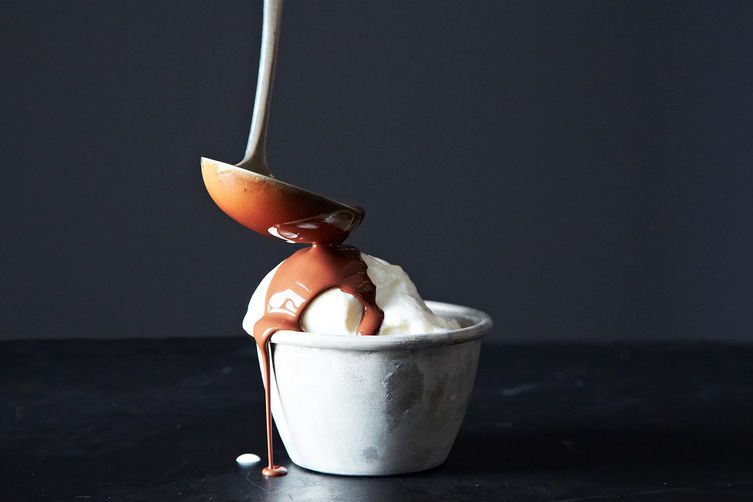
Most everyone screams for ice cream. When making ice cream at home, though, ice cream can make you scream for a whole slew of other reasons. There's the mundane-yet-agonizing chill time before churning, icy ice cream, and the daunting possibility of curdling your custard (darn those yolks!).
If you've ever felt like homemade ice cream can't measure up to the stuff at the shop, freeze it right there. We've collected 15 tips and tricks from some of our favorite ice cream cookbooks that'll have you slathering the inside of your cones with Nutella and adding mix-ins like a master. You'll be (happily) screaming for ice cream in no time.

Big Gay Ice Cream by Bryan Petroff and Douglas Quint
Tip: Line your cones.
“Think of the inside of cones as unused real estate. If an ice cream cone gets a topping, we tell our staff that a little of the topping also goes down into the empty cone. Some customers want an extra wallop of flavor and ask for their cones fully lined. There’s pretty much an endless mix-and-match game you can play with these tasty schmears.”
How to: Before scooping your ice cream, fill the inside of your cone with whatever you fancy. The book suggests nut butters, Nutella, dulce de leche or caramel, jam, balsamic vinegar, olive oil and a bit of sea salt, and fruit curd.
More: The inspiration behind this whacky book.
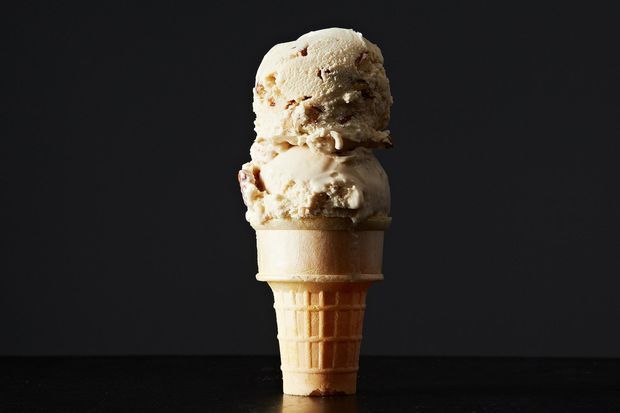
The Beekman Heirloom Dessert Cookbook by Josh Kilmer-Purcell, Brent Ridge, and Sandy Gluck
Tip: Roast the bejesus out of your pecans for exceptional butter pecan ice cream.
“While roasting the pecans for an hour may seem like a really long time, they’ll become super-crisp and won’t soften when added to the ice cream.”
How to: Roast 1 cup pecan halves at 250° F for 50 minutes or until they’re ultra crisp. Add 1 tablespoon cubed, unsalted butter and bake 10 minutes longer or until the butter melts. Toss nuts and butter together. Cool and proceed with ice cream making.
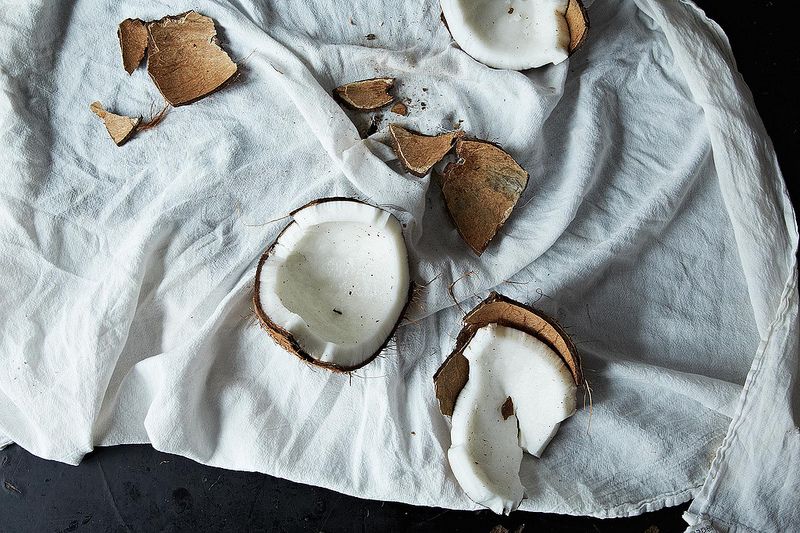
Chez Panisse Desserts by Lindsey R. Shere
Tip: For super coconut-y, coconut ice cream, ditch the can.
How to: Toast unsweetened coconut flakes until golden, then heat the flakes in milk until almost boiling and let steep 20 minutes. Pour through a fine strainer and press the coconut flakes to extract coconut milk. Use this as part of your ice cream base. Shere adds more milk, cream, sugar, egg yolks, and a bit of vanilla extract.

Ample Hills Creamery by Brian Smith and Jackie Cuscuna
Tip: Skim milk powder is your hero.
“Ice cream makers use it combat the effects of too much water in their ice cream base. Milk is almost 90 percent water, and heavy cream is about 60 percent water. You need water to freeze your ice cream, but too much water will freeze into itty-bitty ice cream crystals… and your ice cream will be icy and grainy, not smooth and creamy. Skim milk powder absorbs excess water and givers a milkier, creamier flavor.”
How to: Add about 1/2 cup skim milk powder to the rest of your ice cream base (pre-heating and pre-egg yolk adding). Whisk well to make sure the powder dissolves and no lumps remain.
More: Other tips for avoiding icy ice cream.
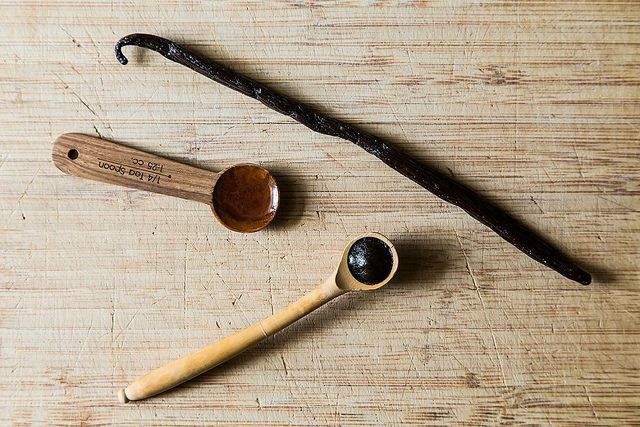
Van Leeuwen Artisan Ice Cream by Laura O’Neill, Benjamin Van Leeuwen, and Peter Van Leeuwen
Tip: For super vanilla-y vanilla bean ice cream, use the bean.
“If you have a Vitamix, purée the vanilla bean pod directly with the dairy mixture after it has steeped; process until the pod has been completely incorporated. It will make your ice cream even more flavorful.”
How to: Do exactly as described above. Any high-powered blender should do the trick—just make sure everything’s homogeneous post-blending.
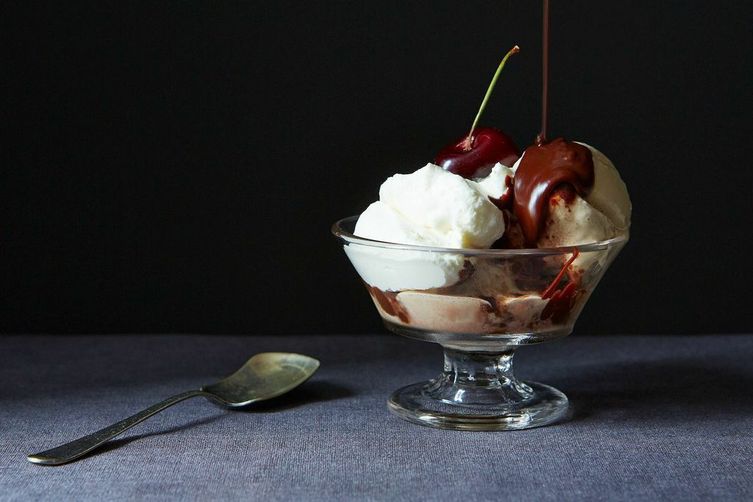
The Perfect Scoop by David Lebovitz
Tip: Alcohol.
“Alcohol does two things in ice cream: It presents ice creams and sorbets from freezing too hard (alcohol doesn’t freeze), and it provides flavor.”
How to: Add a little alcohol (like rum or vodka) to your ice cream or sorbet base. It doesn’t have to be a lot—a couple of teaspoons or a tablespoon. For fruit and berry bases, Lebovitz often uses kirsch, a distillation of cherries, which doesn’t interfere with fruit’s flavor.

Real Sweet by Shauna Server
Tip: Fruit ice creams like flower (water) power.
How to: Add small amounts of flower waters (like rose or orange blossom) to enhance fruit ice cream. Take, for example, rhubarb and rose ice cream. For 1 quart ice cream, Server adds 2 tablespoons of rose water. The idea’s not to give it a “flowery” taste, but highlight the subtleties of the rhubarb.
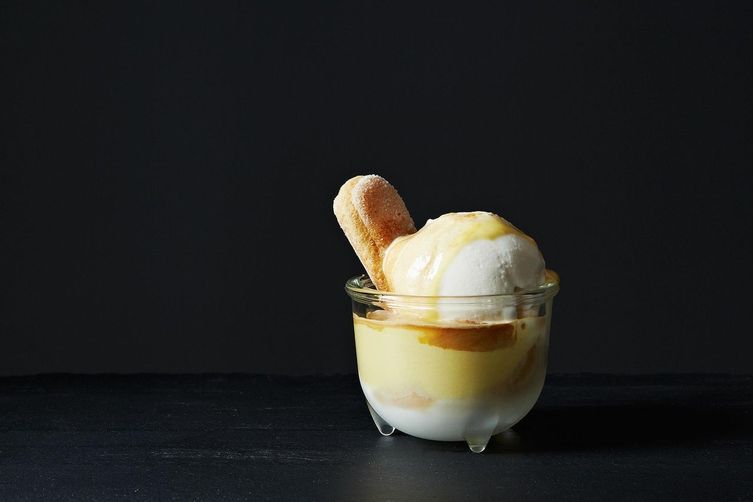
The Art of Making Gelato by Morgan Morano
Tip: Warm your gelato up a little.
“Gelato is usually served at a temperature that is 10 to 15 degrees warmer than American ice cream. The warmer temperature reinforces the creamy texture and stunningly bold flavor of the gelato as it quickly melts in your mouth.”
How to: Let the gelato sit out at room temperature a bit before you serve it. The gelato should be soft enough to easily scoop and drag a spoon through.
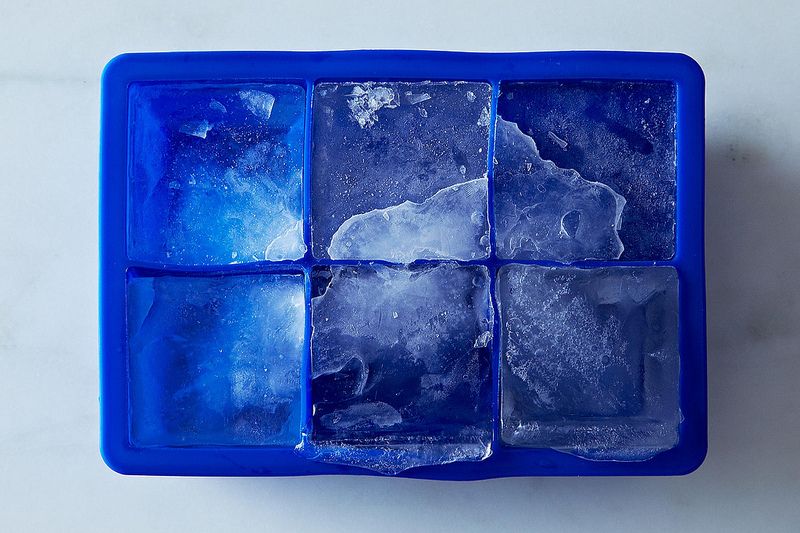
Fancy Desserts by Brooks Headley
Tip: Dry-ice is the best, most uncomplicated, and quickest way of making ice cream and gelato there is.
“Buy the dry ice, in pellets if you can. Don’t touch it, and Jesus Christ, don’t let your child touch it. Put a few cups of dry ice (4 or 5 gold ball-size chunks if you can’t get pellets) in the middle of a kitchen towel and fold the towel over serval times. Smash the dry ice with a heavy pot until it is a powder (no chunks larger than a Grape-Nut). Measure out 1 cup of powdered dry ice. Add this to your gelato mix inside your stand mixer, spin for 2 minutes with the paddle attachment, and put the gelato in a pretty airtight container in the freezer overnight.”
How to: Headley’s directions are detailed, especially the part about not touching it. Seriously, it’s awesome and super cool-looking, but don’t touch it. Dry-ice is extremely cold and will burn you just like something hot.
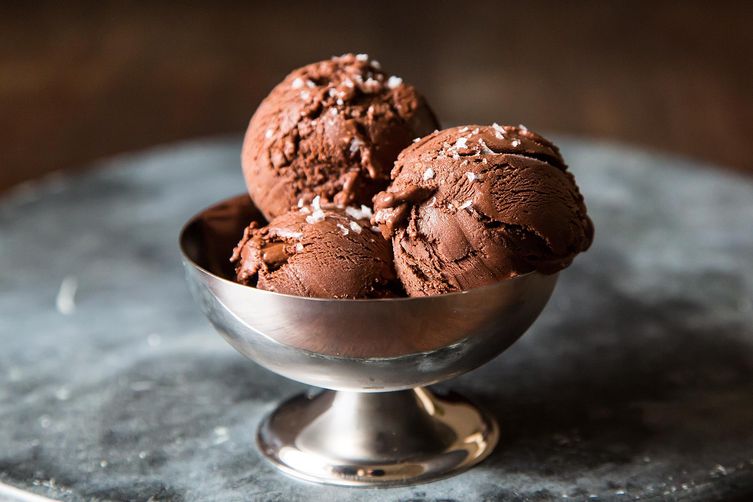
Ready for Dessert: My Best Recipes by David Lebovitz
Tip: Ice cream needs to chill, seriously.
“Ice cream, sorbet, gelato, and sherbet churn up much better—and faster—if the mixture is cold when it’s poured into the ice cream machine. In ice cream recipes, I hold back part of the dairy and strain the custard into it, then chill the mixture over an ice bath to really speed things up. A thoroughly chilled mixture spends a minimum amount of time churning in the machine. The shorter the churning time, the smaller the ice crystals, and the smoother the final texture will be.”
How to: Lebovitz recommends chilling all ice cream, sorbet, and sherbet bases at least 8 hours or, even better, overnight prior to churning.

Momofuku Milk Bar by Christina Tosi
Tip: Use gelatin in your ice cream base instead of eggs to avoid any eggy taste.
“We outsmart the traditional approach to making ice cream (which includes tempering eggs and making an egg-milk mixture, called an anglaise, that thickens as it heats) by using gelatin as a stabilizer. It thickens the ice cream, gives it great body and mouth feel—free of crystallization—and keeps it from melting too quickly when you are scooping a sundae or from freezing too hard once stored in the freezer overnight.”
How to: Bloom gelatin–Tosi uses sheet gelatin—and then blend into base using a blender or immersion blender until fully incorporated.

Bon Appetit Desserts by Barbara Fairchild
Tip: For softening ice cream, the microwave is your friend.
“To mix ingredients into ice cream, or to make a frozen terrine, torte, or pie, the ice cream needs to be soft enough to stir or spread. The quickest and easiest way to rid of that hard chill is to place the carton in the microwave. Heat it in 10-second intervals on the lowest power setting; stir in between intervals to get even softening.”
How to: Do as Fairchild says above. Watch carefully and don’t let it over-melt!
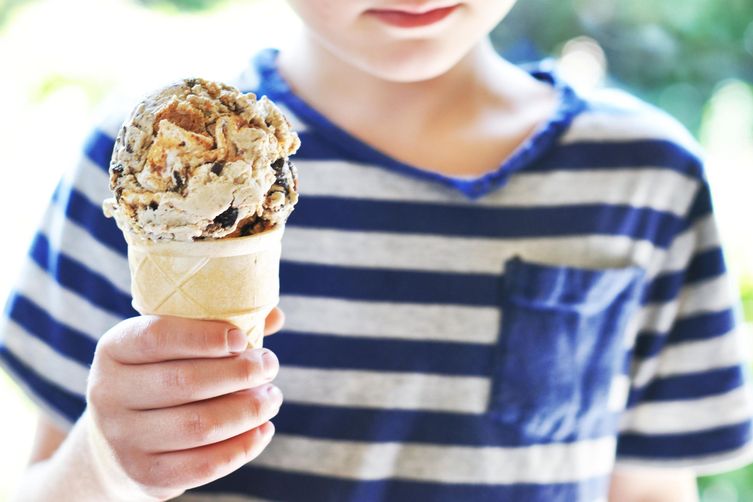
Coolhaus Ice Cream Book by Natasha Case, Freya Estreller, and Kathleen Squires
Tip: Add your mix-ins last.
“As a rule of thumb, save the mix-ins until the end of the freezing process for even distribution and to prevent them from sinking to the bottom.”
How to: Add your mix-ins in the last few minutes of churning or transfer the ice cream to a bowl post-churning and fold them in with a spatula.
On the same mix-in(ish) note, Coolhaus suggests the following: “Cold mutes the flavor of ingredients, so use your taste buds and don’t be afraid to err on the side of generosity when adding spices, herbs, mix-ins, and other flavorings.”
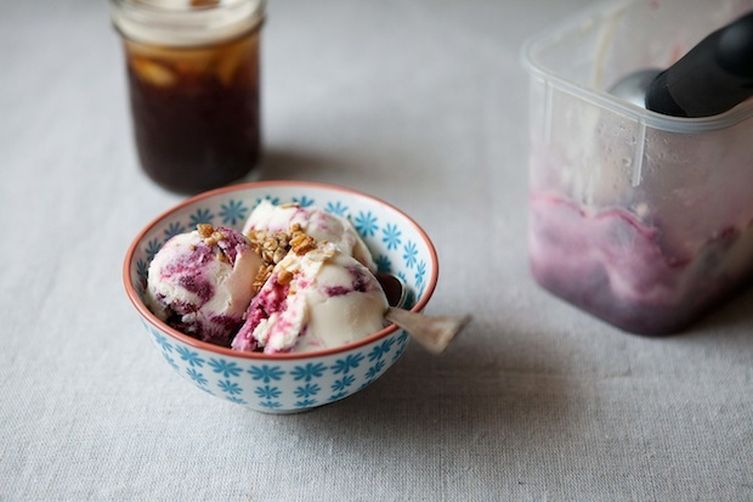
Jeni’s Splendid Ice Cream Desserts by Jeni Britton Bauer
Tip: For best swirls and variegates, don’t simply swirl.
“For layering jams or sauces into ice cream, start by drizzling a spoonful into the bottom the storage container and spreading a layer of ice cream over it. Add a few more spoonfuls into the nooks of the ice cream, and then add another ice cream layer. Continue the sauce and ice cream layering until all the ice cream is used. The sauce should not cover the whole layer. Note that you do not want to ‘swirl’ in the sauce because it will get lost in the ice cream altogether; instead, try to keep it in small pockets throughout the ice cream for a more dramatic presentation and flavor. I also like to add a few final spoonfuls on the top for decoration, just before covering with parchment.”
How to: Like Jeni says, slap some spoonfuls onto and layer that ice cream up—whether that be with jam, fudge sauce, caramel, Nutella, or peanut butter sauce. If you can dream it, you can swirl it (maybe).
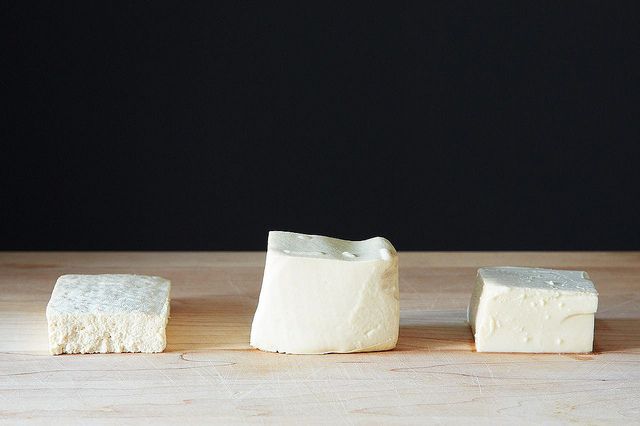
Kyotofu by Nicole Bermensolo
Tip: For a different kind of dairy-free ice cream, try silken tofu.
“It makes a pretty darn convincing stand-in for the heavy whipping cream and egg yolks that give the ice cream its body.”
How to: The cookbook pairs silken tofu, a bit of ripe banana, honey, cocoa powder, and kinako (roasted soy bean flour) for a frozen dessert that’s unnoticeably dairy-free. Blend, churn, and freeze.
Have a favorite ice cream tip or cookbook? Tell us in the comments below!
Photos by Phyllis Grant (s'mores ice cream), fiveandspice (breakfast frozen yogurt), Yossy Arefi (honeycomb ice cream), Anna Hazel (ice cream cones) and the rest James Ransom and Mark Weinberg

















See what other Food52 readers are saying.